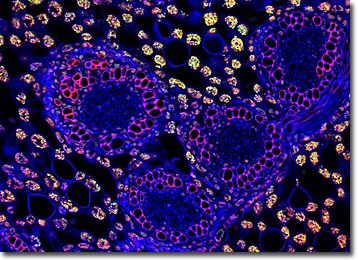 |
 |
 |
|
||||||||||||||||||||||||
 | ||||||||||||||||||||||||
 | ||||||||||||||||||||||||
 | ||||||||||||||||||||||||
Confocal Microscopy Image Gallery
Plant Tissue Autofluorescence Gallery
Sweet Flag Stem
The grass-like perennials that comprise the genus Acorus of the family Acoraceae are commonly known as sweet flag. The plants inhabit moist soils and shallow waters, such as those found in marshes and along the edges of ponds and lakes.

Sweet flag leaves are aromatic when bruised and resemble in appearance the long, narrow leaves of irises, which are also sometimes called flags. When sweet flag blossoms, a rare occurrence, the flowers take the form of brownish-green cylindrical spikes, and the fruit of the plant is an externally dry berry containing a small number of seeds.
A thick subterranean stem called a rhizome allows sweet flag to easily propagate vegetatively and to survive harsh environmental conditions. Sweet flag rhizomes have a spicy fragrance and have been utilized by humans throughout history. Ancient Egyptians considered sweet flag rhizomes aphrodisiacs and various Native American tribes utilized them for both medicinal and ceremonial purposes. The stems have also been featured in the medical remedies of a number of other cultures, but their extracts have been banned from such applications in the United States since the late 1960s, when evidence was found to suggest that they may be carcinogenic.
Contributing Authors
Nathan S. Claxton, Shannon H. Neaves, and Michael W. Davidson - National High Magnetic Field Laboratory, 1800 East Paul Dirac Dr., The Florida State University, Tallahassee, Florida, 32310.
